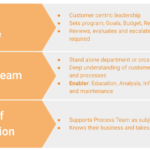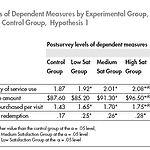Do you ever wonder what separates the organisations that really excel at customer feedback from the ones that fail dismally?
What actually separates Zappos, Amazon, Southwest Airlines and Apple, organisations with outstanding customer loyalty, from the companies you’ve never heard of, because they are entirely forgettable?
Do they have doctorate level statisticians analysing their data? Maybe but that’s not the difference.
Do they have psychologists who write intricate and sophisticated questions? Actually, the very best use simple easy to understand questions and surveys.
Do they have inspired leaders that make everyone just want to provide great customer service? Mostly, but it’s not the inspiration that is the difference.
The real reason these organisations exceed in delivering a great customer experience, and reap the business success it generates, is because they do something with the customer feedback.
Radical. Amazing. Outlandish.
I know, but while many many organisations collect and analyze customer feedback only about 15% actually drive change in their business with that information!
In this research from Temkin you can see that lots of companies are collecting customer feedback. Quite a few analyze the heck out of it. But few collaborate and transform their business with the customer feedback that they collect.

Just think how many millions of surveys and thousands of hours of customer time spent filling in forms that wastes.
If you are already collecting customer feedback, the most effective business improving task you can undertake is to focus on making change.

Acting on Customer Feedback Is a Series of Small Steps
There is no one big thing, no silver bullet, that you must take on if you want to emulate Zappos and Amazon in your business. Instead you need to undertake lots small, easy, steps that each contribute a little bit to improving the business.
Making change in this way is very low risk and will continually improve your business.
Read Every Comment
So let’s start with something really easy: read every comment.
Maybe it sounds simple and straightforward but it doesn’t always occur. One of the most important things you can do is to read every comment that customers provide.
Apart from the obvious, because the customer wrote them, there are several reasons this is so important.
Innovation Opportunities
One of our customers performed an analysis of their customer feedback comments and realized that 1-in-1,000 is a discontinuous innovation opportunity.
By that I mean it’s a whole new way of doing business. It’s a new business line. It’s a new part of their business. It’s a new way of doing business.
It’s an idea that comes from their customers that radically improves their business.
This is innovation you’re not going to find inside your business and it’s coming directly from your customers
Take Immediate Action
About 5% of comments will be an action that you need to take in the business. It may be directly related to specific customer or be something that you need to do as part of your general business.
Sales Opportunities
You’ll also find customers providing you with business leads in their comments.
I’m amazed at the number of leads that come in through customer feedback forms. Customers will often leave comments that say “Please contact me because I want a proposal to do X”.
If you’re not reading the comments you’re missing out on free business leads, and no-one wants to do that.
Service Recovery
The next action that’s really important is service recovery.
This piece of service recovery research shows that:
A customer that has been unhappy and has told you about it, and then has had the issue fixed, is more loyal than a customer that’s never had a problem with your business.
I think you’ll agree this is a startling finding.
To reiterate:
- If you have a customer that’s expressed unhappiness in their dealings with your business, and
- You proactively save that customer or fix their problem,
- They will be more loyal and sing your praises louder than a customer that has never had an issue
So service recovery is a simple action that every business can perform to generate more loyal customers.
Okay so it may seem like making calls to unhappy customers would be a drag but you’ll be surprised. Sure there will be a couple of people that will be negative but overall our experience shows that this is a positive task for the staff making the calls.
This is because these customers are, in most cases, happy to talk to you because they are still engaged with your organisation.
Remember these are people who, for whatever reasons, had a negative experience with your organisation. Yet they were still engaged enough to respond to the survey and provide a comment about that experience.
By and large they are giving you an opportunity to fix whatever went wrong. If you take them up on that opportunity they will thank you for it and become even more loyal.

Latent sales opportunities
It is also amazing how often these service recovery calls result in the opportunity to upsell customers to new products and services
So there’s a lot of value you can get out of this service recovery process. In fact, if you only did one thing with your customer feedback, do this. It is probably the most valuable, easiest, and fastest thing you can do.
Taking Action In the Business
Now that the easy stuff is out of the way we need to dig in a bit deeper to using customer feedback to drive change in your business.
At this point you need to start to analyse your customer feedback to find on-going or root cause issues in your business. If a good proportion of your customers are complaining about a specific aspect or element of your business then you should investigate how to prevent that issue from arising.
Let’s take an example of a customer problem that we solved in a recent workshop. One participant had identified that a large number of the pieces of customer feedback to their business referenced a very specific issue.
While they knew the specific area was a problem for customers the solution that came up with was not working. Essentially they would explain to each customer at check-in (this is a hospitality business) how to resolve the issue.
The trouble is that the instructions are moderately complex and when customers are checking in they are not the least bit concerned about the specific issue even though they will become very concerned in a few hours.
The business owner’s reaction was to blame the customers for not listening to the instructions. However, even if all customer did listen, the solution was poor, because when it gets busy at check-in, which it invariably does, the owner did not have time to explain the issue to all of their customers. So only some of the customers receive the instructions to a problem that affects them all.
The root cause of the issue is clouded in this situation but, in the seminar the company used the 5 Whys Process to uncover it. They identified the root cause as “customer does not have the required instructions at the time they need them”.
Simple with hindsight.
To resolve this, now, relatively simple root cause, the idea of placing written instructions at the point of the issue was raised. This is a good resolution to the issue and provides at least two benefits to the business:
- Customers are not frustrated by the issue.
- The business costs are lowered — no longer does the business owner have to spend time with every customer explaining how to resolve the issue.
As you can see the final resolution to the issue was not difficult but it took several distinct steps before it was identified and resolved.
No one step is difficult in and of itself but ensuring that they are all addressed can sometimes take some consistent effort.
The Steps to Taking Action
Identify that there is an issue.
It’s odd but it is not always clear that an issue exists.
In this example the business owner initially identified the issue as “customers do not listen properly to the instructions that they are given”. With this root cause there is little that can be done to resolve the issue.
However, applying a different perspective helped show the issue is not with the client but how the organisation delivers the information. All of a sudden there are lots of ways to resolve the issue.
Identify a common issue
While resolving individual customers issues is important, the changes that you most want to implement must have as much leverage as possible. They must affect lots of customers.
In this case the half of all negative feedback for this company related to this one issue so resolving it would instantly lift the overall customer satisfaction.
Identify that the current resolution is not working
Here again a change of perspective can often be a valuable way to identify a resolution that is not working. Too often we assume that it is the customer at fault when in fact it is the business design that is at fault.
If this is a common customer complaint or issue then you should be in no doubt that the issue is with the organisation not the customer.
Identify the root cause of the issue
This is not as simple as it at first appears.
Approaches such as 5 Whys Root Cause Analysis are designed specifically to help us get to the underlying root causes of the issue.
Commonly when we look at problems we jump too quickly to solutions before getting to the real root cause. Relax and really investigate the issue before settling on what you think is the root cause.
As a way of determining if you have the real root causes check to see if it is a business process. Individual resolutions are not often the root cause but business process lapses often are.
In this case the root cause was initially thought to be “customers not listening to instructions” when in fact it was “customers not able to able to absorb and remember instructions that will only be relevant in several hours time”.
Identify a useful (practical, affordable, etc.) response
Here again, once the root cause it uncovered it can be surprisingly easy to resolve.
Once the fact the root cause was identified as the instructions being given too far away in time and location from the issue, the solution was simple. Bring the instructions closer in time and place to the issue: put a detailed sign at the point the customer needs to execute on the instructions.
It can be easy to look at a case study like this and think that the resolution is obvious but it is only so with the benefit of 20/20 hindsight.
It took some time and conversation in the workshop to simply move from “the customer doesn’t listen properly” to “we are not communicating effectively, regardless of how well we think we are doing”.
Once that revelation occurred the rest of the process was less difficult to work through.
Don’t Just Sit There Do Something
While collecting and analyzing customer surveys seems like the task of customer feedback is isn’t: doing something is the real task.
It may seem like an enormous task to fix everything but remember in this case the resolution was a sign that took 10 minutes to create. So start small. Read some customer comments. Identify an issue. Solve it. Rinse and repeat and you’ll be in the top 15% of organizations.






